During the COVID pandemic, Melbourne, Australia’s second largest city, was second to none when it came to lockdowns. From March 2020 to October 2021, the city endured six lockdowns for a total of 262 days, more days by far than any other city on Earth. In the midst of the pandemic, Gary Hardy realized the looming threat of another long spell of being homebound could be put to good use as a compelling argument to build another boat.
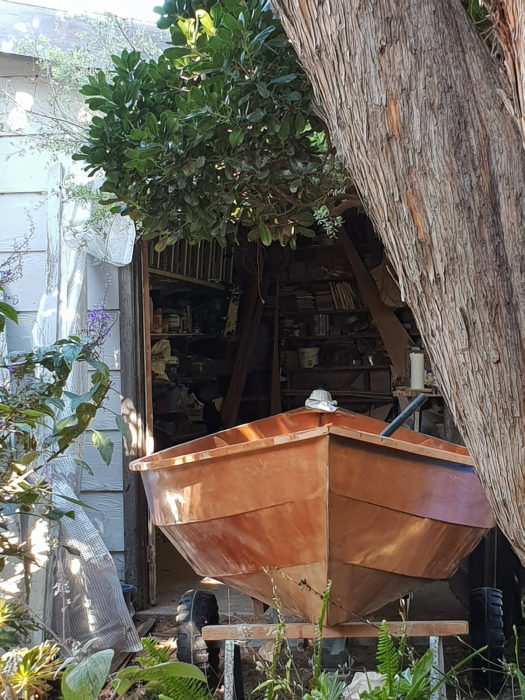 Photographs courtesy of Gary and Anne Hardy
Photographs courtesy of Gary and Anne HardyThere wasn’t much room in the shed for building the 15′-long Skerry. When the weather permitted, the hull could be rolled out on a dolly and set on sawhorses, where there is fresh air and a lot more elbow room.
He had been retired for a few years and could do with his time pretty much as he wished, and what he wished to do was build another boat. That required a negotiation with his wife, Anne. The 17′ plywood kayak he had built before retiring had taken over their home’s lounge room, and when Gary finished the project he had to take out a window to move the kayak out of the house. Anne was reluctant to have another boat built on a diagonal across a room meant for relaxing, and the two agreed on something much smaller: a cradle boat. Gary bought the plans for Chesapeake Light Craft’s 7′ 9″ Eastport pram and scaled it down to bunk a grandchild. Christened SEA PUP, it has remained unused as no grandchildren are yet in the works.
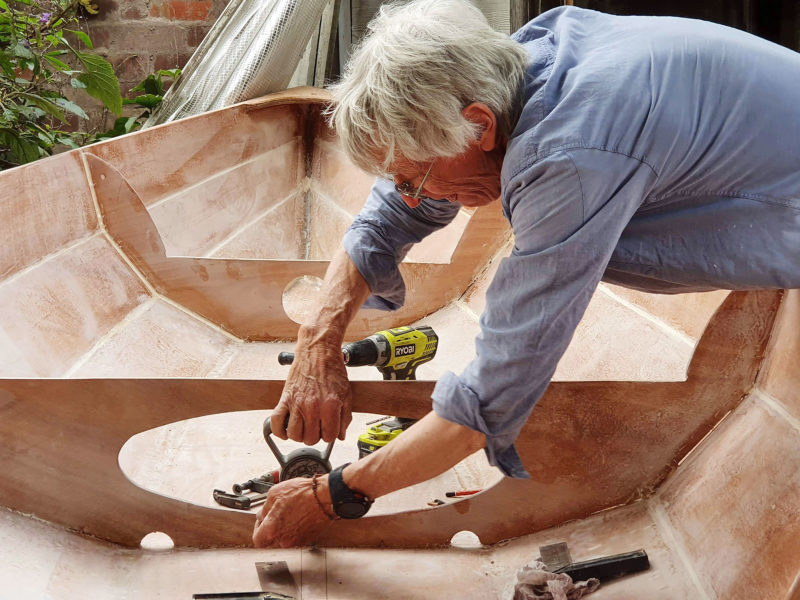
Working outdoors in the Australian sunshine often provided good lighting for work on the Skerry. Gary has a cordless drill, but sometimes a vintage hand-cranked drill is the right tool for the job.
When Gary foresaw another lockdown coming, he once again entered negotiations with Anne about building yet another boat. This time it was Chesapeake Light Craft’s Skerry, a 15′ double-ender for oar and sail. “I argued that building a boat was an important mental health measure.” To up the ante even further he put the Skerry kit on his pointedly specific Christmas and December birthday wish lists. He also placed the order.
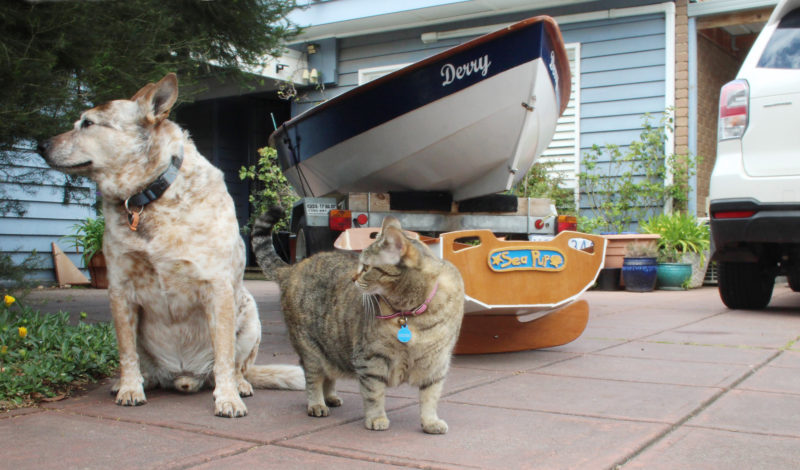
DERRY was launched after SEA PUP, an Eastport pram scaled down and equipped with rockers to serve as a cradle boat for an as-yet nonexistent grandchild. The Hardy’s cat, Maggie, is a rescue like their dog Ozzie, but that shared background doesn’t make them good friends. Maggie bosses him mercilessly.
Gary didn’t get to build the Skerry in the lounge. The project was relegated to the shed, and he had to sell his Mirror dinghy to make room. It was a tight fit. “Somehow, either my shed was smaller or the Skerry bigger than I anticipated, but I managed.” The lockdown he had seen coming did indeed happen, and Melburnians once again spent most of their time at home. For Gary, “building during lockdown was a blessing and kept me sane and happy.” Building a boat in cramped quarters required some gymnastics, adding to the mental health measures some physical benefits: “Squeezing round the edges to build that boat was extremely good for stretching and flexibility.” After the hull was finished, he put the Skerry on a dolly so he could move it out of the shed during fair weather and work on it in the garden.
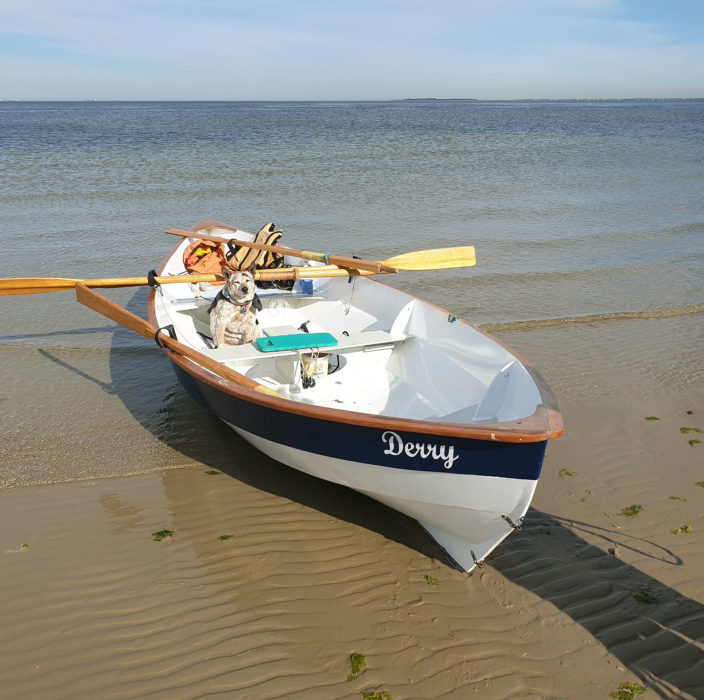
Getting away from Maggie may be one of the pleasures Ozzie takes in boating. Flat water and a light breeze are to his liking.
Gary christened the finished boat DERRY, his mother’s maiden name. It was what his father called his mother since their courtship, when he gave her a book he had inscribed “for Derry is my darling.”
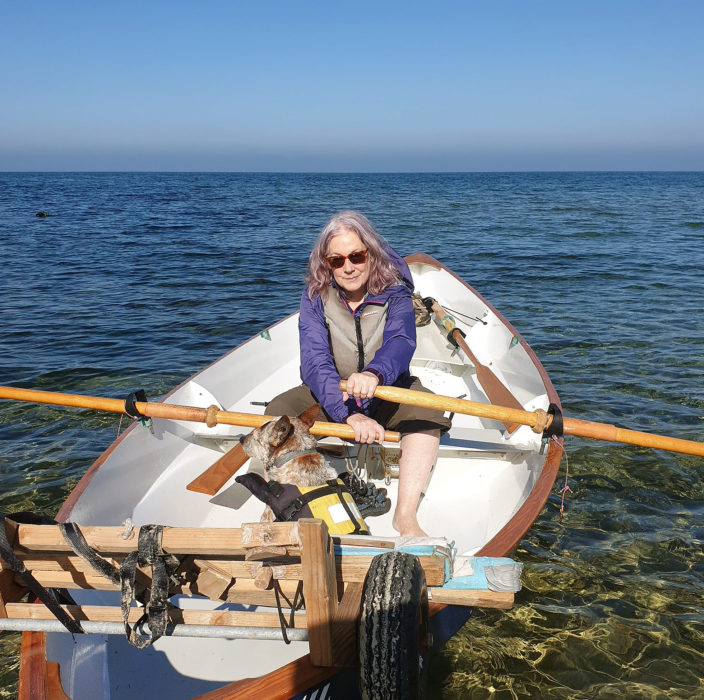
Ozzie took in the scene while Anne, Gary’s wife, took to the oars. The cart used to get DERRY to the water rests on the stern.
Gary has been pleased with the Skerry’s performance: “a real delight to sail and row.” And Anne “loves it, much more than any of the boats I have owned in the past.” Gary added side benches in the bow to provide a comfortable spot for Anne to be while sailing. With the boat’s two rowing stations they can also row together; “a nice companionable activity.”
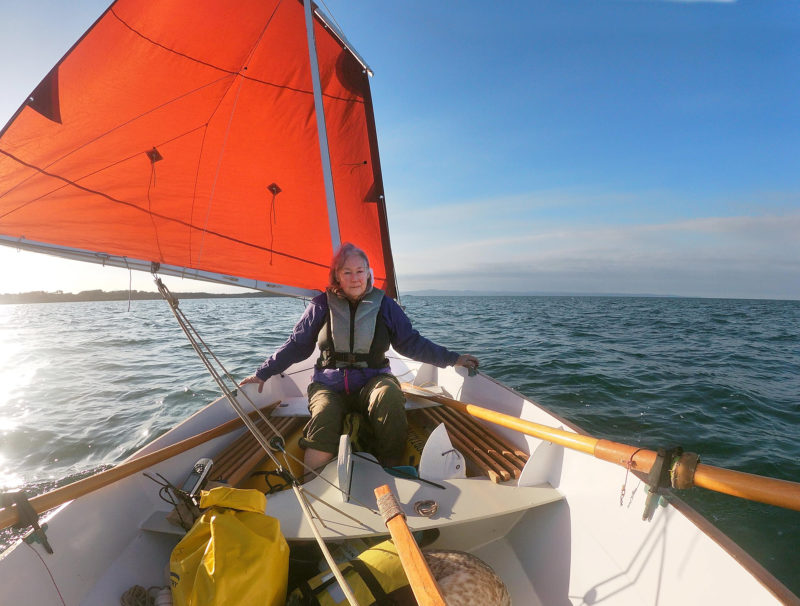
Anne has also taken to sailing DERRY. Ozzie, taking a snooze in his yellow PFD (bottom center), seemed a bit indifferent to it.
Ozzie, the couple’s two-year-old Australian Cattle Dog, is Gary’s other sailing companion. “A key characteristic of this breed is an extraordinary level of loyalty. Ozzie is profoundly miserable if I go out sailing without him. Australian Cattle Dogs are also extremely good at communicating how they are feeling. He has an unerring way of letting me know he will go with whatever we are doing because he is a good, loyal dog, but he may be very, very unhappy about it.” While getting doused with spray while DERRY was beating to windward, Ozzie glared at Gary through eyes narrowed with reproach.
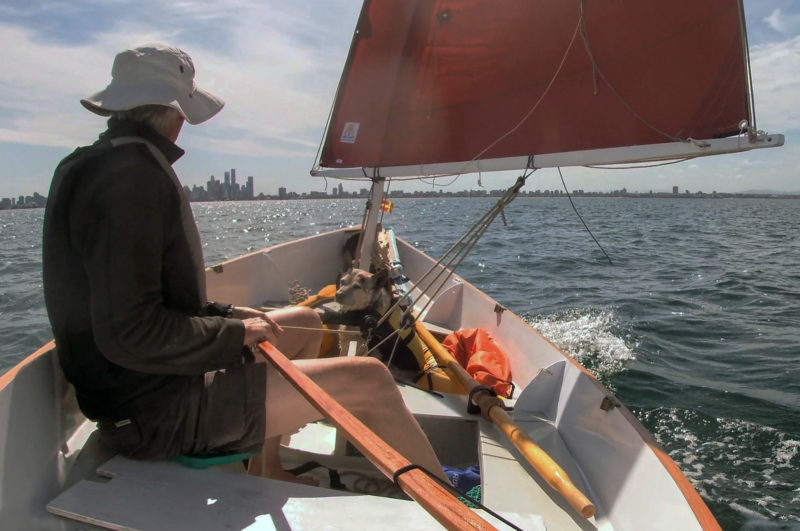
With DERRY beginning to heel, Ozzie wasn’t in the mood for napping.
Gary then devised a dodger to shelter Ozzie. After making a prototype from a poly tarp, he sewed up a canvas version to be supported by a curved PVC pipe anchored in the forward oarlock sockets. “Ozzie certainly approves of the enhancement, and I have found it is very cozy to snug down behind it for a morning coffee. If I can persuade Ozzie to move over.”
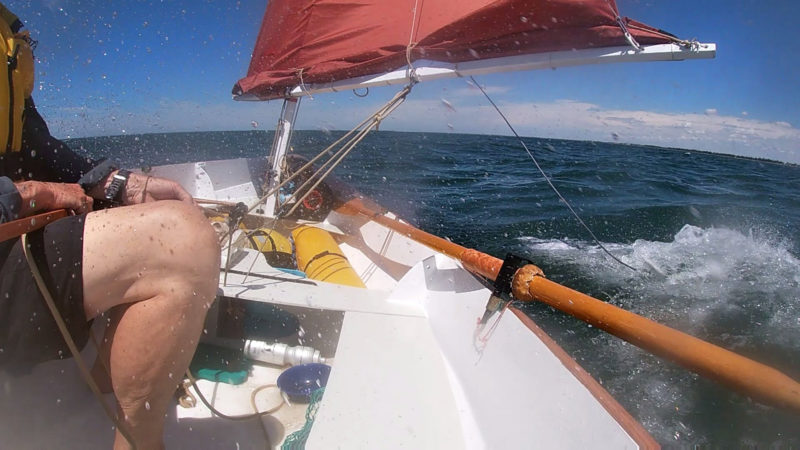
As the breeze freshens and the spray began to fly, Ozzie hunkers down. His PFD is just below the mast and his glaring eye is visible by Gary’s kneecap.
Gary made several other additions to the Skerry, which were inspired by articles in Small Boats: a Paddook, a Norwegian tiller keeper, a Spinnaker for rowers, cord-wrapped oarlocks for the sculling station, one of those nifty mainsheet cam-cleat things that fit into the oarlock socket, and even a bed frame made from Ikea bed slats.
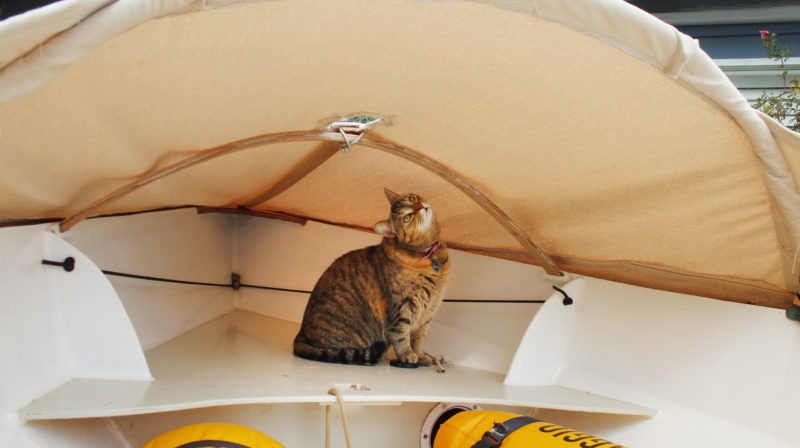
The dodger Gary made for Ozzie’s comfort got a good looking over by Maggie.
Gary has entered DERRY for next February’s Tawe Nunnagah 2023, a raid that runs over nine days and 140 nautical miles up the east coast of Tasmania—what he describes as “a fantastic but wild stretch of water.” If all goes well, he’ll finish in Hobart in time for the Hobart Wooden Boat Festival.
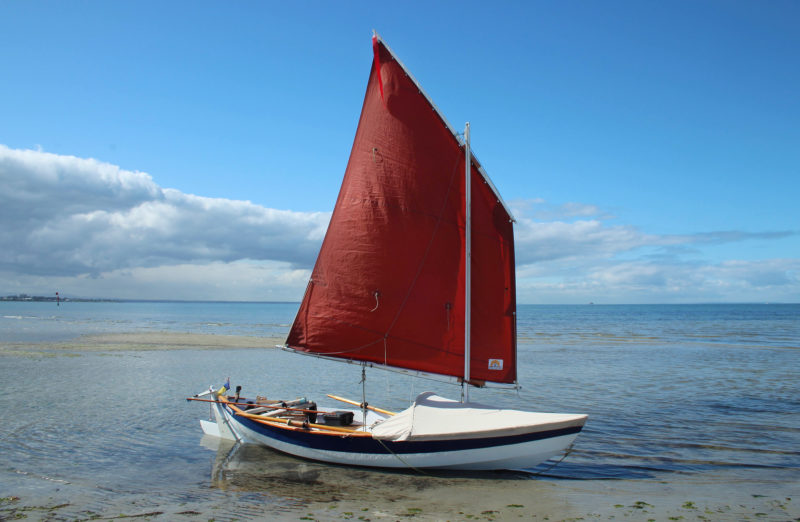
The dodger keeps Ozzie out of the wind and spray and makes sailing a bit more tolerable.
While DERRY is getting put to use frequently and has a busy post-pandemic future lined up, the cradle boat SEA PUP gathers dust. “My children have so far studiously avoided taking the hint of the cradle boat, and SEA PUP is still waiting for her crew. But Anne and I live in hope.” ![]()
Do you have a boat with an interesting story? Please email us. We’d like to hear about it and share it with other Small Boats Magazine readers.

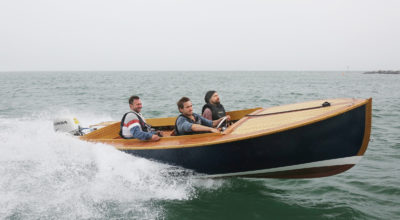
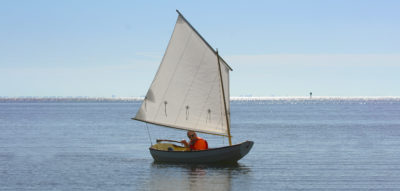


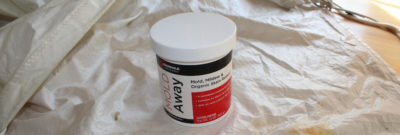
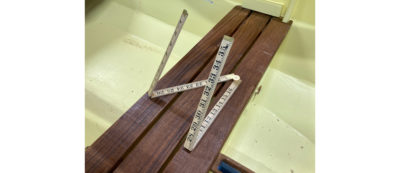
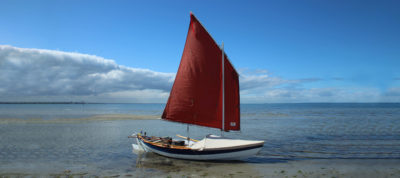
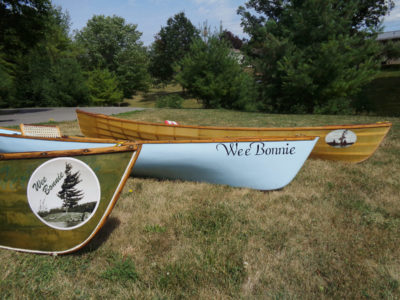
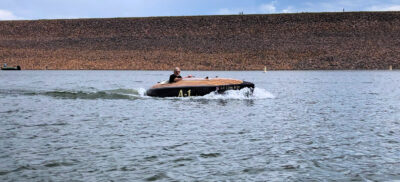
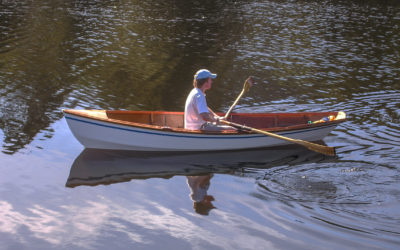
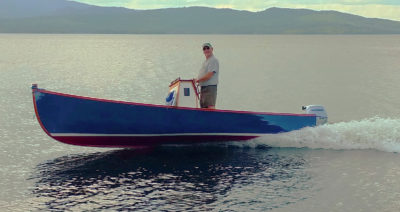
I’m delighted to see such a well-equipped Skerry. I built mine a few years back because I wanted to learn how to sail and figured I have to start by knowing how to build it. Now that I know what I love in small boats, I’ve always felt let down by its ability to “cruise.” A lot of your modifications tell me I’m just not being creative enough. How did you do the side benches aft?
How does the dodger marry into the forward oarlocks?
As for the Norwegian tiller keeper. Shop time is hard for me to come by between work and parenting so I found that a line made off from the yoke or tiller (depending on tack) on a cleat just aft of the aft frame acts as a “limiter” to what the rudder can do and basically pulls her downwind where the weatherhelm on the sprit rig pulls her back into that line. And this was a development that happened underway as opposed to shoreside shop time!
I’m thinking I want to chop the rudder head off flush and make a crucifix bitt on the aft breasthook for towing things and making fast an outrigger for salmon trolling on a hand line. Kooky dreams for when I’m not so occupied by the raising of my three deckhands.
All that to say, very impressed by your efforts with this fantastic little boat. Very salty!
From the SF Bay Area,
-Josh
Thank you, Josh, that’s very kind. Yes, the Skerry is a fantastic little boat!
The side benches in the pictures in the article are my “Mark 1” version, based closely on pictures and plans that I got from the wonderful Arwen Marine website.
The site is treasure trove of creative ideas and inspiration for Skerries and other small boats.
I built the seats you can see in the photos pretty much to the plans on the Arwen site. The ply top sits on a curved laminated frame which slots into cleats screwed onto the aft and centre bulkhead. They work well, but they are heavy, and one reason I really like the Skerry is its lightness. So I have subsequently made “Mark II” seats, which are simply straight slats of Douglas Fir, with a hinged support that swings down to prevent any bending in the middle. I run a bungee cord through a hole drilled into one of those rowing foot supports on the floor and up through the seat slats to hold the side seats in place. I made a pair for the crew position; you can see them in the photo of my wife with the sail behind her. They worked fine and were significantly lighter, so I made some the same for the rear seating as well.
For the dodger, I used a nylon swivel arrangement, the sort that people use for attaching small bimini hoods to boats. The bottom part of the swivel (a Saint Marine Nylon Deck Mount) is screwed into a small block of wood. Into that block of wood I have epoxied a bit of oak dowel the right diameter to fit into the oarlock. So far so good.
I like your line preventer arrangement for self steering! I will have to give that a try.
I find a lot of the fun of having a small boat that I built myself is that I feel empowered to evolve it, to dream up ways to tweak it and make it work for me better. I figure if I built it, I can change it, or I can reconstruct it back to the way it was if things don’t work out.
Good luck with those deckhands. Hopefully you can get them signed up soon to help implement some of the “kooky ideas.” (Which I am sure are not kooky at all.)
Thanks again, happy Skerry sailing,
Gary
Gary, thanks for your article. Curious about the bed-slats. Across from what and what did you lay them across (in the Skerry)? Were it not for that center thwart….. Am sorely attempted to amputate one side of it, from the centerboard trunk to the side planks, but am too concerned that such a measure would overly degrade the structural integrity of the hull.
Gary, I think I see now what you did, from one of your pictures, re the cross-slats – you’d added side benches to your Skerry, from the middle thwart, aft, and so was able to put the slats across the two benches.
Thanks Brad. Yes, the slats go across the side benches forward of the centre thwart. With the centre board and the rear seat board laid crossways across the rear benches I have a reasonably roomy platform. I have yet to test it on an overnighter however. Like you, I have thought hard about somehow enlarging the gap in that centre bulkhead, or removing the darn thing altogether, but have come to the same conclusion structure wise. I see Galen Piehl on the Skerry Facebook group has modified his Skerry to remove that bulkhead. If the thwart level platform doesn’t work out in practice I might get out the saw and attack that bulkhead.